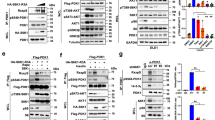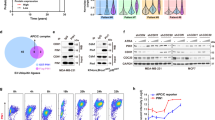Abstract
The serine/threonine protein kinase B (PKB, also known as Akt) plays a pivotal role in diverse cellular functions. Elevated expression of activated Akt has been detected in a wide variety of human cancers; however, the mechanism of Akt protein stability regulation remains unclear. In this study, we showed a strong correlation between the expression levels of an oncogenic peptidyl-prolyl cis/trans isomerase Pin1 and levels of Akt phosphorylation at S473 in multiple cancer types (P<0.0001). Akt-pS473 status combined with Pin1 expression levels predicted a poorer prognosis than did either one alone in patients with breast cancer (P=0.0052). We further showed that Pin1 regulated Akt stability and phosphorylation on S473 through the phosphorylated Thr-Pro motifs of Akt. These motifs are conserved evolutionary and are required for the maintenance of Akt stability and its interaction with Pin1. In addition, repressing Pin1 expression through either homologue Pin1 knockout or small interfering RNA-mediated knockingdown compromised its ability to protect Akt from degradation. Our results show how Akt protein stability is regulated by the peptidyl-prolyl cis/trans isomerase Pin1 and highlight the importance of this oncogenic network in human disease pathogenesis.
This is a preview of subscription content, access via your institution
Access options
Subscribe to this journal
Receive 50 print issues and online access
$259.00 per year
only $5.18 per issue
Buy this article
- Purchase on Springer Link
- Instant access to full article PDF
Prices may be subject to local taxes which are calculated during checkout





Similar content being viewed by others
References
Alessi DR, Andjelkovic M, Caudwell B, Cron P, Morrice N, Cohen P et al. (1996). Mechanism of activation of protein kinase B by insulin and IGF-1. EMBO J 15: 6541–6551.
Bao L, Kimzey A, Sauter G, Sowadski JM, Lu KP, Wang DG . (2004). Prevalent overexpression of prolyl isomerase Pin1 in human cancers. Am J Pathol 164: 1727–1737.
Bayascas JR, Alessi DR . (2005). Regulation of Akt/PKB Ser473 phosphorylation. Mol Cell 18: 143–145.
Bellacosa A, Chan TO, Ahmed NN, Datta K, Malstrom S, Stokoe D et al. (1998). Akt activation by growth factors is a multiple-step process: the role of the PH domain. Oncogene 17: 313–325.
Bellacosa A, Kumar CC, Di Cristofano A, Testa JR . (2005). Activation of AKT kinases in cancer: implications for therapeutic targeting. Adv Cancer Res 94: 29–86.
Bhaskar PT, Hay N . (2007). The two TORCs and Akt. Dev Cell 12: 487–502.
Brazil DP, Yang ZZ, Hemmings BA . (2004). Advances in protein kinase B signalling: AKTion on multiple fronts. Trends Biochem Sci 29: 233–242.
Brognard J, Sierecki E, Gao T, Newton AC . (2007). PHLPP and a second isoform, PHLPP2, differentially attenuate the amplitude of Akt signaling by regulating distinct Akt isoforms. Mol Cell 25: 917–931.
Burgering BM, Medema RH . (2003). Decisions on life and death: FOXO Forkhead transcription factors are in command when PKB/Akt is off duty. J Leukoc Biol 73: 689–701.
Carpten JD, Faber AL, Horn C, Donoho GP, Briggs SL, Robbins CM et al. (2007). A transforming mutation in the pleckstrin homology domain of AKT1 in cancer. Nature 448: 439–444.
Cha TL, Zhou BP, Xia W, Wu Y, Yang CC, Chen CT et al. (2005). Akt-mediated phosphorylation of EZH2 suppresses methylation of lysine 27 in histone H3. Science 310: 306–310.
Chan TO, Rittenhouse SE, Tsichlis PN . (1999). AKT/PKB and other D3 phosphoinositide-regulated kinases: kinase activation by phosphoinositide-dependent phosphorylation. Annu Rev Biochem 68: 965–1014.
Chan TO, Tsichlis PN . (2001). PDK2: a complex tail in one Akt. Sci STKE 2001: PE1.
Cully M, You H, Levine AJ, Mak TW . (2006). Beyond PTEN mutations: the PI3 K pathway as an integrator of multiple inputs during tumorigenesis. Nat Rev Cancer 6: 184–192.
Dillon RL, White DE, Muller WJ . (2007). The phosphatidyl inositol 3-kinase signaling network: implications for human breast cancer. Oncogene 26: 1338–1345.
Du K, Tsichlis PN . (2005). Regulation of the Akt kinase by interacting proteins. Oncogene 24: 7401–7409.
Dummler B, Hemmings BA . (2007). Physiological roles of PKB/Akt isoforms in development and disease. Biochem Soc Trans 35: 231–235.
Facchinetti V, Ouyang W, Wei H, Soto N, Lazorchak A, Gould C et al. (2008). The mammalian target of rapamycin complex 2 controls folding and stability of Akt and protein kinase C. EMBO J 27: 1932–1943.
Finn G, Lu KP . (2008). Phosphorylation-specific prolyl isomerase Pin1 as a new diagnostic and therapeutic target for cancer. Curr Cancer Drug Targets 8: 223–229.
Gao T, Furnari F, Newton AC . (2005). PHLPP: a phosphatase that directly dephosphorylates Akt, promotes apoptosis, and suppresses tumor growth. Mol Cell 18: 13–24.
Guertin DA, Sabatini DM . (2005). An expanding role for mTOR in cancer. Trends Mol Med 11: 353–361.
Ikenoue T, Inoki K, Yang Q, Zhou X, Guan KL . (2008). Essential function of TORC2 in PKC and Akt turn motif phosphorylation, maturation and signalling. EMBO J 27: 1919–1931.
Kang S, Bader AG, Vogt PK . (2005). Phosphatidylinositol 3-kinase mutations identified in human cancer are oncogenic. Proc Natl Acad Sci USA 102: 802–807.
Kops GJ, Burgering BM . (1999). Forkhead transcription factors: new insights into protein kinase B (c-akt) signaling. J Mol Med 77: 656–665.
Liao Y, Hung MC . (2003). Regulation of the activity of p38 mitogen-activated protein kinase by Akt in cancer and adenoviral protein E1A-mediated sensitization to apoptosis. Mol Cell Biol 23: 6836–6848.
Lin SY, Xia W, Wang JC, Kwong KY, Spohn B, Wen Y et al. (2000). Beta-catenin, a novel prognostic marker for breast cancer: its roles in cyclin D1 expression and cancer progression. Proc Natl Acad Sci USA 97: 4262–4266.
Lu KP, Suizu F, Zhou XZ, Finn G, Lam P, Wulf G . (2006). Targeting carcinogenesis: a role for the prolyl isomerase Pin1? Mol Carcinog 45: 397–402.
Lu KP, Zhou XZ . (2007). The prolyl isomerase PIN1: a pivotal new twist in phosphorylation signalling and disease. Nat Rev Mol Cell Biol 8: 904–916.
Lu PJ, Zhou XZ, Shen M, Lu KP . (1999). Function of WW domains as phosphoserine- or phosphothreonine-binding modules. Science 283: 1325–1328.
Luo J, Manning BD, Cantley LC . (2003). Targeting the PI3K-Akt pathway in human cancer: rationale and promise. Cancer Cell 4: 257–262.
Manning BD, Cantley LC . (2007). AKT/PKB signaling: navigating downstream. Cell 129: 1261–1274.
Maroulakou IG, Oemler W, Naber SP, Tsichlis PN . (2007). Akt1 ablation inhibits, whereas Akt2 ablation accelerates, the development of mammary adenocarcinomas in mouse mammary tumor virus (MMTV)-ErbB2/neu and MMTV-polyoma middle T transgenic mice. Cancer Res 67: 167–177.
Muise-Helmericks R, Grimes HL, Bellacosa A, Malstrom SE, Tsichlis PN et al. (1998). Cyclin D expression is controlled post-transcriptionally via a phosphatidylinositol 3-kinase/Akt-dependent pathway. J Biol Chem 273: 29864–29872.
Newton AC . (2003). Regulation of ABC kinases by phosphorylation: protein kinase C as a paradigm. Biochem J 370: 361–371.
Sarbassov DD, Guertin DA, Ali SM, Sabatini DM . (2005). Phosphorylation and regulation of Akt/PKB by the rictor-mTOR complex. Science 307: 1098–1101.
Soung YH, Lee JW, Nam SW, Lee JY, Yoo NJ, Lee SH . (2006). Mutational analysis of AKT1, AKT2 and AKT3 genes in common human carcinomas. Oncology 70: 285–289.
Takahashi K, Uchida C, Shin RW, Shimazaki K, Uchida T . (2008). Prolyl isomerase, Pin1: new findings of post-translational modifications and physiological substrates in cancer, asthma and Alzheimer/s disease. Cell Mol Life Sci 65: 359–375.
Testa JR, Tsichlis PN . (2005). AKT signaling in normal and malignant cells. Oncogene 24: 7391–7393.
Tokunaga E, Oki E, Egashira A, Sadanaga N, Morita M, Kakeji Y et al. (2008). Deregulation of the Akt pathway in human cancer. Curr Cancer Drug Targets 8: 27–36.
Wulf G, Garg P, Liou YC, Iglehart D, Lu KP . (2004). Modeling breast cancer in vivo and ex vivo reveals an essential role of Pin1 in tumorigenesis. EMBO J 23: 3397–3407.
Xia W, Chen JS, Zhou X, Sun PR, Lee DF, Liao Y et al. (2004). Phosphorylation/cytoplasmic localization of p21Cip1/WAF1 is associated with HER2/neu overexpression and provides a novel combination predictor for poor prognosis in breast cancer patients. Clin Cancer Res 10: 3815–3824.
Yang ZZ, Tschopp O, Baudry A, Dummler B, Hynx D, Hemmings BA . (2004). Physiological functions of protein kinase B/Akt. Biochem Soc Trans 32: 350–354.
Yeh E, Cunningham M, Arnold H, Chasse D, Monteith T, Ivaldi G et al. (2004). A signalling pathway controlling c-Myc degradation that impacts oncogenic transformation of human cells. Nat Cell Biol 6: 308–318.
Yeh ES, Means AR . (2007). PIN1, the cell cycle and cancer. Nat Rev Cancer 7: 381–388.
Zacchi P, Gostissa M, Uchida T, Salvagno C, Avolio F, Volinia S et al. (2002). The prolyl isomerase Pin1 reveals a mechanism to control p53 functions after genotoxic insults. Nature 419: 853–857.
Acknowledgements
This project has been supported by funds from the Department of Defense Breast Cancer Research Program (DAMD17-01-1-0300), the Susan G Komen Foundation (BCTR0504146), a Research Development Award from the SPORE in Ovarian Cancer (P50-CA83639-A01) (to LY), and by the grant support from the NIH P01 099031, P20 CA101936 (MDACC Pancreatic Cancer SPORE), P50 CA116199 (MDACC Breast Cancer SPORE), P50 CA83639 (MDACC Ovarian Cancer SPORE), Marcus Foundation, National Breast Cancer Foundation, Inc., and Kadoorie Charitable Foundations (to M-C H). We acknowledge Dr Martin L Campbell at the Synthetic Antigen Laboratory, The University of Texas MD Anderson Cancer Center, for the synthesis of the phospho- and non-phospho-peptides as well as the NIH core grant to MD Anderson Cancer Center (CA16672). We thank Drs Xiangho He, Tiebang Kang, Bo Ping, Pingyu Zhang, Weiya Xia, and Mr William Spohn for their participation in the earlier development of this project. We also appreciate Dr Hay N (University of Illinois, Chicago, IL, USA), Dr Lu KP (Department of Medicine, Beth Deaconess Medical Center, Harvard Medical School, Boston, MA, USA), and Dr Xiao Z (Department of Biochemistry and Department of Medicine, Boston University School of Medicine, Boston, MA, USA) for their kindness in providing us the Akt1 MEF cells, Pin1 MEF cells, and Pin1 constructs. We are grateful for the technical assistance from Dr Jeng C Cheng and Dr Stephanie A Miller during the preparation of this paper. We also greatly appreciate the editing and language improvement of this paper by Ms Kristi Speights at the Department of Scientific Publication, The University of Texas MD Anderson Cancer Center.
Author information
Authors and Affiliations
Corresponding authors
Additional information
Supplementary Information accompanies the paper on the Oncogene website (http://www.nature.com/onc)
Rights and permissions
About this article
Cite this article
Liao, Y., Wei, Y., Zhou, X. et al. Peptidyl-prolyl cis/trans isomerase Pin1 is critical for the regulation of PKB/Akt stability and activation phosphorylation. Oncogene 28, 2436–2445 (2009). https://doi.org/10.1038/onc.2009.98
Received:
Revised:
Accepted:
Published:
Issue Date:
DOI: https://doi.org/10.1038/onc.2009.98
Keywords
This article is cited by
-
Targeting Akt in cancer for precision therapy
Journal of Hematology & Oncology (2021)
-
(–)-Epigallocatechin-3-gallate induces apoptosis and differentiation in leukaemia by targeting reactive oxygen species and PIN1
Scientific Reports (2021)
-
Pin1 inhibition exerts potent activity against acute myeloid leukemia through blocking multiple cancer-driving pathways
Journal of Hematology & Oncology (2018)
-
Arsenic targets Pin1 and cooperates with retinoic acid to inhibit cancer-driving pathways and tumor-initiating cells
Nature Communications (2018)
-
Chemical or genetic Pin1 inhibition exerts potent anticancer activity against hepatocellular carcinoma by blocking multiple cancer-driving pathways
Scientific Reports (2017)



